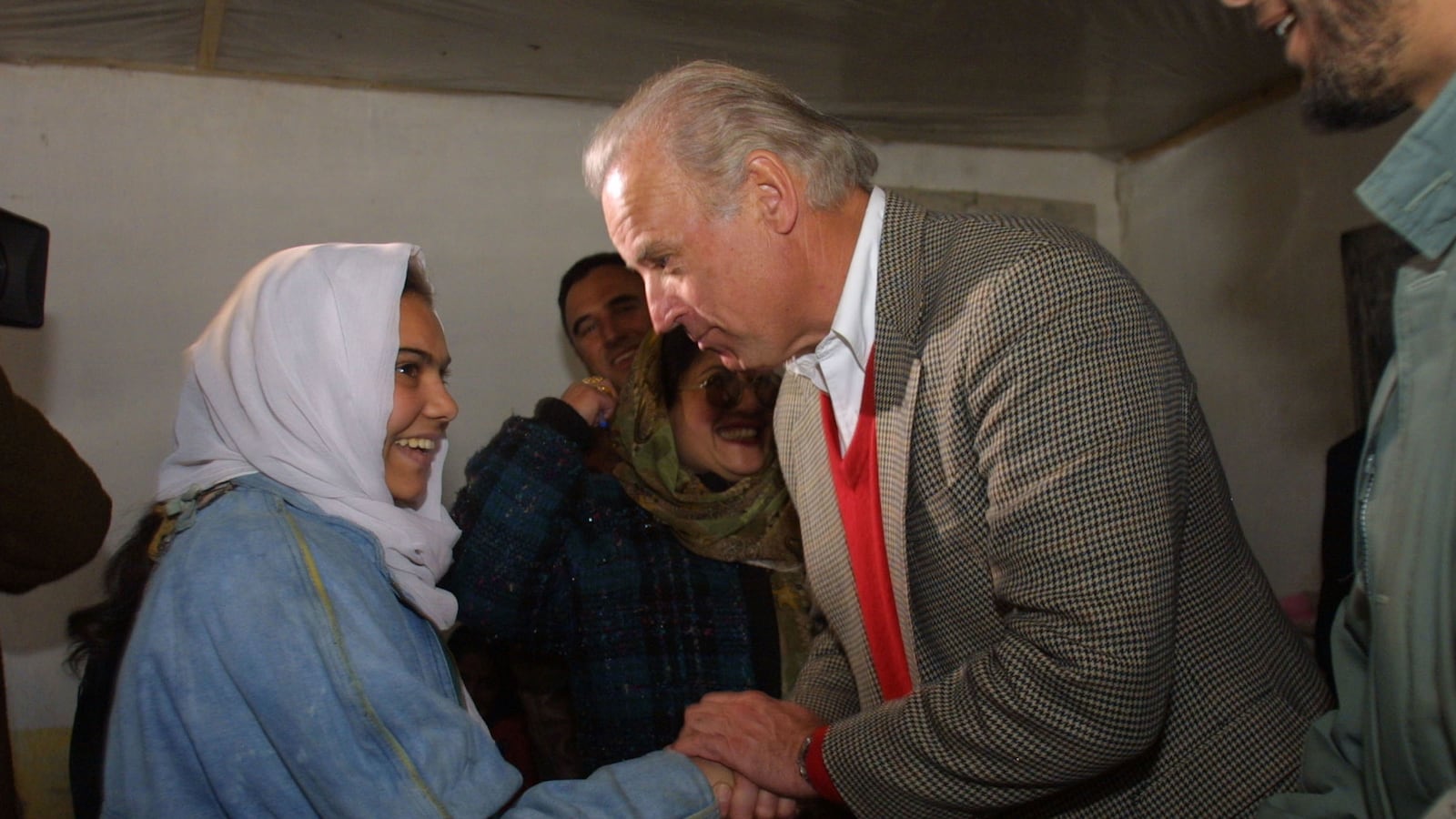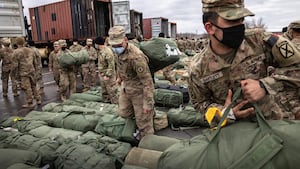Kandahar, one of the major Afghan cities that fell to the Taliban this week, is named after a man who once reportedly said that Afghanistan was “easy to march into, hard to march out of.” His name was Alexander the Great. Another city that fell, Herat, was briefly a capital within the empire of Timur, known to many in the west as Tamerlane, who also, for a time, was known as “the Great.” Herat was seen as a jewel of the empire, one of the great crossroads and cultural capitals of the world.
A painting depicting a lone British army surgeon on horseback approaching Jalalabad, a city that has not yet fallen to the Taliban but may well do so soon, became a symbol of the high cost and futility of Britain’s Afghan interventions. Called “Remnants of an Army,” it depicted the sole survivor of an army of 16,000, William Brydon, approaching the city during a retreat from Kabul during the First Anglo-Afghan War in January, 1842. It was painted by Elizabeth Thompson, Lady Butler, in 1879 in the midst of the Second Anglo-Afghan War. There was, briefly, a third such war in 1919.

It is a cliché now, to the extent useful historical context can be characterized as such, to note that the interventions of foreign powers in Afghanistan are typically difficult and more often than not end badly for the invaders. The litany of those who came and went, who grappled with the reality of a largely poor, fragmented tribal society, difficult physical terrain and an ebbing will to pay the price Afghanistan demands of its visitors, is strikingly long. It includes the Persians, the Greeks, Arabs, Mongols, Mughals, Sikhs, the British, the Soviets and to what will be the enduring discredit of America’s leaders, us.
While history offered U.S. leaders 3,000 years of warnings, it does not offer them an excuse.
When George W. Bush ordered U.S. troops into the country less than a month after the September 11, 2001 attacks, he did what any U.S. president would have done. He sought to strike back at the perpetrators of those attacks and those that harbored them. However, almost immediately he began to undertake a series of errors that not only echoed those of the past but should serve as a cautionary tale as stark and poignant as Lady Butler’s painting.
This is important to understand now as the extent of America’s compound failures in Afghanistan become apparent to all. That is because there is a chorus seeking to lay the blame for what is happening in Afghanistan now at the doorstep of President Joe Biden when, in fact, the disaster there represents not only the culmination of millenia of regional history but of decades of bad decisions by U.S. political and military leaders.
America’s errors actually predated 9/11. They began in 1979 when, in response to the Soviet invasion of Afghanistan, the U.S. began to provide support to mujahedin fighters who sought to drive out that foreign invader. The mujahedin included many groups and tribes, some of which can be traced to the emergence of Al Qaeda and some of which can be traced to the eventual rise of the Taliban a decade and a half later that would eventually provide a haven to Osama bin Laden. Also participating in this lapse of foresight were the Pakistanis, who have continued to provide support for the Taliban for years, and the Saudis, about whose dangerous funding of extremists most Americans already know much.
In the wake of Russia’s failure in Afghanistan, which some call the Soviet “Vietnam,” political chaos among rival factions in that country led in the mid-90s to the emergence of an extreme faction that felt that only through strict adherence to a rather twisted view of Islamic law could the country be saved. Led by a mullah named Mohammad Omar, the Taliban grew from a few dozen in mid-1994 to thousands. Between late 1994 and September 1996, they seized the country in a brutal blitzkrieg with echoes of this year’s onslaught. They were extreme, cruel, and tolerant of very little except, to their misfortune, the presence of other extremists in their mix.
They paid a heavy price for this when a group of those extremists under bin Laden’s leadership carried out the 9/11 attacks. By early October, we were bombing Taliban and Al Qaeda positions. It was soon after that things began to go terribly wrong.
At the same time we entered Afghanistan, U.S. Vice President Dick Cheney and his Secretary of Defense, Donald Rumsfeld, began to agitate for the U.S. to also target Iraq — a country that had absolutely nothing to do with the September 11th attacks. The war in Iraq would prove not only to be a disaster in its own right but one that drew the attention and resources of U.S. policymakers, planners and commanders away from Afghanistan.
At the same time, despite Bush infamously declaring “mission accomplished” in the Spring of 2003, the American invasion of Afghanistan gradually became seen as a long-term effort to hunt down all extremists and to try to remake the country’s institutions so that they would be able to permanently keep the peace even as the Taliban began to regroup. A multi-year U.S. presence triggered the same reaction among many in Afghanistan that the Soviets (and so many others before them) had. By the end of 2004, Mullah Omar formally launched an effort to push the U.S. out.
Despite the efforts of U.S. troops, the Taliban gained strength. U.S. military strategies achieved small, short-term gains. But efforts to strengthen local institutions and security forces produced spotty, largely unsatisfactory results. The war dragged on. It cost over a trillion dollars and thousands of lives.
When Barack Obama took office in 2009, he started with a review of the U.S. war in Afghanistan. It took 9 months. By its conclusion, some, including his Vice President Joe Biden, were calling for the U.S. to wind down the war. Others, including ultimately Obama, suggested a “brief” surge of additional troops. By 2011, the U.S. had achieved a real “Mission Accomplished” moment, killing Osama bin Laden who, at the time, was not even in Afghanistan any longer. The war there dragged on.
Many on Obama’s team wanted out of Afghanistan but all worried that pulling out would lead to a swift Taliban take-over. Donald Trump entered office vowing to end the war but his efforts were forestalled because military leaders told him that by pulling out all the troops they would be inviting a collapse. They sought negotiations with the Taliban despite the fact that there is no evidence the Taliban would actually have honored any agreement and there is plenty to suggest otherwise. That did not stop Trump from announcing a departure date for U.S. troops that would ultimately fall on the watch of his successor.
When Biden came into office, he delayed that departure date. But he could not ignore the obvious. America no longer had any pressing national interest in Afghanistan that would warrant a permanent presence like in Germany (to support NATO and offset Russian strength) or in Korea (to help counter the threat from North Korea). Our efforts to support the central government and retrain the military were not gaining necessary traction. Terrorist groups had largely decamped to other parts of the world. Further, Biden had 20 years of evidence that a U.S. presence on the ground would not and could not achieve the kind of stability that would ensure that upon our departure the country would not immediately revert to the Taliban.
So Biden did what his predecessors had not dared to do. He made the hard decision to leave, knowing that the political fallout from the inevitable aftermath would fall on him. (He also knew that stay or go, his critics would attack him.) But there were no better alternatives recommended by anyone. And by leaving, our troops would no longer be at risk, our costs would be contained, and our attentions could be devoted to higher priorities. He and his team correctly argued that the U.S. military was not the way to advance our longer-term objectives in the country, which would have to be handled by diplomats and international institutions.
Should they have made clear the international response that would follow the abuse of Afghanistan’s women or the curtailing of any human rights in that country? Should it have been strong and swift? Should they have made it even clearer than they did that any emergent terror threats would be met with immediate force—missile or drone attacks or Special Forces? Should they have better prepared to evacuate and give harbor to those who aided us during our time in Afghanistan? Could that have involved keeping the airbase at Bagram open until all key allies, friends and U.S. staff could be evacuated?
Yes. Yes, they should have done all those things.
But, they could not have forestalled the outcome we are seeing now without keeping a permanent U.S. presence in the country. The Taliban were long poised to do what they are doing (otherwise they could not be doing it). Further, the swiftness of the Taliban action, designed to discredit the U.S. government, reveals all we need to know about their intentions as does the brutality of their actions. The ineffectiveness of the government to stop them after all these years of training and expense also suggests that more years of the same would not have produced a different outcome.
Joe Biden is doing the right thing. His team is not executing the departure well. He and they bear responsibility for that. But they no more bear the primary responsibility for the fiasco that was America’s longest war than did Gerald Ford did for all our errors in Vietnam when the last U.S. helicopter lifted off the roof of the U.S. embassy in Saigon on April 30 of 1975.
It could be argued that every U.S. administration from Carter through Trump bears greater responsibility for what went wrong with U.S. policy in Afghanistan than Biden’s. What is going on there now is awful. But make no mistake, getting out and getting out now is what we needed to do. Continuing to do what had not worked for two decades would only meet the famed definition of insanity. Biden recognized that it is the job of leaders sometimes to do painful things, things that damage them politically.
Nearly three quarters of all Americans believe, however, that we should be out of Afghanistan. There was no will in the U.S. to do anything other than what Biden has done. And now, with some luck, we can move on. We can move on to seek to help the people of Afghanistan with international initiatives that contain real carrots and penalties with real teeth. We can let those countries with a long-term stake in the region take a leadership role in shaping what happens next in Afghanistan. We can shift our focus to real U.S. priorities and needs.
And hopefully, we can learn the manifold lessons of history—of ours and of other great powers before us—to avoid fucking up again so colossally in the future.





